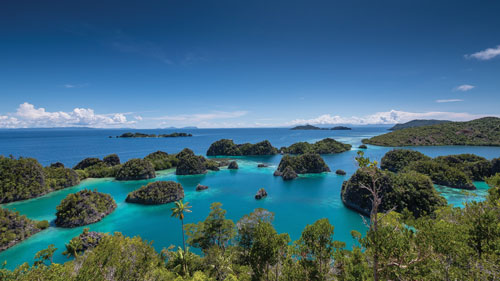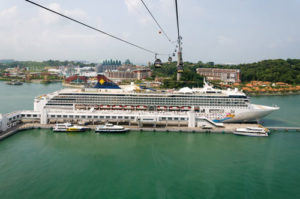How will Indonesia’s lifting of cabotage restrictions shape the future development of South-east Asia’s cruise industry?

In a bid to boost arrivals, the Indonesian government has recently relaxed its cabotage principles imposed on cruise ships by allowing foreign vessels to anchor at selected ports in the country.
International cruise lines can now embark/disembark tourists through the seaports of Benoa (Bali), Tanjung Priok (Jakarta), Tanjung Perak (Surabaya), Belawan (Medan) and Soekarno-Hatta (Makassar).
Cruise companies interviewed by TTG Asia are salivating at the prospects of a larger domestic cruise market and more interesting itineraries.
Welcoming the development, Michael Goh, senior vice president – sales, Star Cruises, said: “We foresee it will have a significant and positive impact on the region, boosting the development of both the domestic and South-east Asian cruise markets.
“Recently, Star Cruises had completed its 46-night Southern Hemisphere cruise onboard SuperStar Virgo, calling at several ports in Indonesia including Jakarta and Bali late last year. With the new ruling, this will enable Star Cruises to explore new itineraries and most importantly, expand our reach in Indonesia, as the country has the making and potential to be one of the leading cruise hubs in the region.
Buhdy Bok, Costa Group’s Asia president, is equally positive: “As a key market for Costa, Indonesia’s latest move provides a huge opportunity to develop the cruise market both domestically and around the region. We are always keen to explore new itineraries in the region, and are excited to see the development of more itineraries with the increase in port calls in Indonesia, enriching our cruise holiday offerings for guests in the Asia region.”
Melvyn Yap, regional director-Asia of Silversea Cruises, said: “The Indonesian archipelago is a long stretch. This will give us a lot of time to explore all the beautiful islands instead of trying to get to another country just to meet the cabotage requirements.”
It is hence not surprising that Indonesia’s outbound operators are viewing the cabotage lift in positive light, especially as Indonesians, who still need to fly out of the country to embark on a cruise ship, will be able to sail from domestic ports in the future.
Nurdin Supena, manager, Bayu Buana Travel, said: “It would be more attractive for Indonesians because it means reduced cost in terms of air tickets to Singapore, and it is also time-effective to be able to hop onto a cruise from Jakarta as the major outbound market comes from here.
“The cruise package prices need to be attractive though,” she added. “The most important thing, however, is the readiness of the ports to berth the big ships which are operating in the region nowadays.”
Furthermore, the ability to cruise from homeground will likely appeal to Indonesian travellers seeking to enjoy the facilities on board a ship, rather than those whose cruise journeys are motivated by the destination, observed Rama Tirtawisata, group managing director of Panorama Leisure Group.
“The new policy opened up more opportunities to grow the first group, as it would be more convenient for them to start their trips from Indonesia. For these people, the destination is not the main interest, and short (South-east Asian) cruise programmes such as Singapore-Port Klang-Phuket are popular.
“For the second group – those who would travel to places like the Mediterranean or Alaska – the new policy does not bring any change,” he added.
At the same time, Rama also sees ample opportunities for international cruise lines to roll out domestic programmes for Indonesians across the sprawling archipegalo. “Indonesia has so many interesting destinations such as Togean and Raja Ampat which are not easily accessible by air, and cruising can be a good alternative for adventurous Indonesians,” he said.
Likewise, Lim Chee Tong, managing director of Malaysia’s Jebsen Travel & Tours Services, foresees cruise lines will offer itineraries to more exotic destinations in Indonesia beyond current ports of calls like Komodo Island and Bali. “This will benefit agents as they will have more products to sell,” he said.
On the other hand, Richard Vuilleumier, managing director, Panorama Tours Malaysia, foresees a lukewarm reception for all-Indonesian itineraries, as many Malaysians have already been to Indonesia for shopping, sightseeing, golfing and cultural experiences, and therefore would rather take cruises to novel destinations farther afield.

John Chan, business consultant at Malaysia’s Kris International Traveltours, views the cabotage lift as the nascent development of the Indonesian cruise industry and as it matures, there will be more opportunities for corporate companies to hold their incentive events onboard a cruise ship, with embarkation and disembarkation in Indonesia.
He commented: “For the Malaysian market, Indonesia will be a new destination for cruise holidays as compared to Southern Thailand and Hong Kong. Malaysia will also benefit as passengers could transit at the international airports here before boarding an onward flight to Indonesia.”
The biggest loser may be Singapore, which has established itself as the cruise hub of South-east Asia.
Alicia Seah, director of marketing communications at Dynasty Travel, deems the cabotage lift a threat as it will “definitely affect and reduce the numbers” boarding from Singapore.
She said: “With Indonesia’s big population base numbers, secondary cities will benefit to depart from their homeport country rather than via Singapore where accommodation and transfers will definitely cost more.”
Echoing similar sentiments, Chan Brothers Travel Singapore’s marketing communications executive, Rebecca Chia, commented: “With the lifting of cabotage of the sea, we foresee that passengers from Jakarta may choose to embark and disembark from their homeports instead of Singapore for domestic and regional cruising.
“We have seen bookings from the Indonesia market gaining traction only in the last two years, with majority of travellers originating from Batam, Jakarta and Yogyakarta. (Nevertheless), they may still find it more convenient to embark and disembark from Singapore than through their own seaports due to our strategic location within South-east Asia,” Chia said.
However, the trade is not expecting Indonesia to compete with Singapore’s cruise hub position yet.
Seah added: “We reckon that there will be challenges in (the Indonesia cruise industry) for at least the next two to three years in terms of infrastructure building as well as pricing strategies as they may be pegged against the US dollar.”
Star Cruises’ Goh urged: “We hope Indonesia will continue to implement cruise-friendly measures and develop the overall cruise tourism network, economy and infrastructure for the selected seaports, which are equally important in order to attract more cruises and tourists to the country in the near future.”
This article was first published in TTG Asia, January 8, 2016 issue, on page 11. To read more, please view our digital edition or click here to subscribe.
Additional reporting from S Puvaneswary and Paige Lee Pei Qi




















